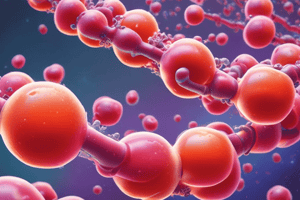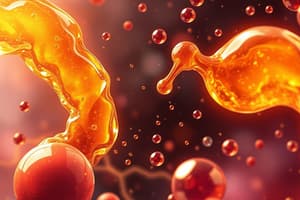Podcast
Questions and Answers
What characterizes saturated fatty acids?
What characterizes saturated fatty acids?
- Contain multiple double bonds
- Have no double bonds (correct)
- Always exist as triglycerides
- Are a type of phospholipid
Which level of protein structure involves local folding patterns such as α-helixes and β-sheets?
Which level of protein structure involves local folding patterns such as α-helixes and β-sheets?
- Secondary structure (correct)
- Primary structure
- Quaternary structure
- Tertiary structure
In enzyme kinetics, what does the Km value indicate?
In enzyme kinetics, what does the Km value indicate?
- Rate of reaction at maximum substrate concentration
- Maximum velocity of the enzyme
- Affinity of the enzyme for the substrate
- Concentration of substrate at half Vmax (correct)
Which of the following accurately describes phospholipids?
Which of the following accurately describes phospholipids?
What is the primary function of sterols in cellular membranes?
What is the primary function of sterols in cellular membranes?
How are essential amino acids defined?
How are essential amino acids defined?
Which statement about competitive inhibition is true?
Which statement about competitive inhibition is true?
What forms the double helix structure of DNA?
What forms the double helix structure of DNA?
Which of the following best describes the process of transcription?
Which of the following best describes the process of transcription?
What is the primary role of ATP in metabolism?
What is the primary role of ATP in metabolism?
Which metabolic pathway involves the conversion of glucose to pyruvate?
Which metabolic pathway involves the conversion of glucose to pyruvate?
In the context of genetic mutations, which statement is correct?
In the context of genetic mutations, which statement is correct?
Which technique is primarily used for amplifying specific DNA sequences?
Which technique is primarily used for amplifying specific DNA sequences?
What is primarily produced during the Krebs Cycle?
What is primarily produced during the Krebs Cycle?
Flashcards are hidden until you start studying
Study Notes
Lipid Biochemistry
- Definition: Study of lipids' structure, function, and metabolism in biological systems.
- Types of Lipids:
- Fatty Acids: Saturated (no double bonds) and unsaturated (one or more double bonds).
- Triglycerides: Glycerol + three fatty acids; main form of stored energy.
- Phospholipids: Glycerol + two fatty acids + phosphate group; key component of cell membranes.
- Sterols: Four fused carbon rings; e.g., cholesterol, important for membrane fluidity.
- Functions:
- Energy storage
- Structural role in membranes
- Signaling molecules (e.g., hormones)
Protein Structure
- Levels of Structure:
- Primary: Sequence of amino acids.
- Secondary: Local folding patterns (α-helix, β-sheet) stabilized by hydrogen bonds.
- Tertiary: Overall 3D structure formed by interactions among R groups.
- Quaternary: Assembly of multiple polypeptide chains into a functional unit.
- Amino Acids: 20 standard amino acids; classified as essential and non-essential.
- Protein Folding: Assisted by chaperones; misfolding can lead to diseases (e.g., Alzheimer's).
Enzyme Kinetics
- Definition: Study of the rates of enzyme-catalyzed reactions.
- Key Concepts:
- Substrate: The reactant that enzymes act on.
- Active Site: Region where substrate binds.
- Michaelis-Menten Kinetics: Describes the rate of enzymatic reactions with respect to substrate concentration.
- Vmax: Maximum reaction velocity.
- Km: Substrate concentration at which the reaction rate is half of Vmax.
- Inhibition:
- Competitive: Inhibitor resembles substrate; competes for active site.
- Non-competitive: Inhibitor binds elsewhere; reduces enzyme activity regardless of substrate concentration.
Molecular Genetics
- Definition: Study of the molecular basis of gene structure and function.
- DNA Structure: Double helix formed by nucleotides (adenine, thymine, cytosine, guanine).
- Gene Expression:
- Transcription: DNA → mRNA.
- Translation: mRNA → protein.
- Mutations: Changes in DNA sequence, can lead to genetic diversity or diseases.
- Techniques:
- PCR (Polymerase Chain Reaction): Amplifies specific DNA sequences.
- CRISPR: Gene editing technology for targeted modifications.
Metabolism
- Definition: Set of life-sustaining chemical reactions in organisms.
- Categories:
- Catabolism: Breakdown of molecules to obtain energy (e.g., glycolysis).
- Anabolism: Synthesis of complex molecules from simpler ones (e.g., protein synthesis).
- Energy Currency: ATP (adenosine triphosphate) used for energy transfer.
- Key Pathways:
- Glycolysis: Conversion of glucose to pyruvate; produces ATP and NADH.
- Krebs Cycle: Oxidation of acetyl-CoA to CO2; generates electron carriers (NADH, FADH2).
- Electron Transport Chain: Series of protein complexes; uses electrons from NADH and FADH2 to produce ATP through oxidative phosphorylation.
Lipid Biochemistry
- Lipids are crucial biomolecules encompassing structure, function, and metabolism within living organisms.
- Fatty acids can be saturated (lacking double bonds) or unsaturated (containing one or more double bonds).
- Triglycerides consist of glycerol bonded to three fatty acids; they serve as the primary storage form of energy in organisms.
- Phospholipids feature glycerol, two fatty acids, and a phosphate group; essential for forming cell membranes and their integrity.
- Sterols, such as cholesterol, possess four fused carbon rings and play a vital role in maintaining cell membrane fluidity.
- Key functions of lipids include energy storage, structural roles in biological membranes, and acting as signaling molecules (e.g., hormones).
Protein Structure
- Proteins exhibit four levels of structure:
- Primary structure is the linear sequence of amino acids.
- Secondary structure includes local folding patterns such as alpha-helices and beta-sheets, held together by hydrogen bonds.
- Tertiary structure is the complete three-dimensional arrangement of a polypeptide chain.
- Quaternary structure arises from the assembly of multiple polypeptide chains into a functional protein complex.
- There are 20 standard amino acids categorized as essential (obtained from diet) and non-essential (synthesized by the body).
- Protein folding is facilitated by molecular chaperones; improper folding can lead to diseases, exemplified by Alzheimer's.
Enzyme Kinetics
- Enzyme kinetics focuses on the speed of enzyme-catalyzed reactions and their regulation.
- Substrates are the reactants that enzymes convert to products.
- The active site is the specific region of the enzyme that binds the substrate.
- Michaelis-Menten kinetics models the relationship between substrate concentration and reaction velocity.
- Vmax represents the maximal rate of reaction, while Km indicates the substrate concentration at which the reaction rate is half of Vmax.
- Inhibition types include:
- Competitive inhibition, where an inhibitor mimics the substrate and competes for the active site.
- Non-competitive inhibition, where an inhibitor binds to a different site and reduces enzyme activity irrespective of substrate presence.
Molecular Genetics
- Molecular genetics studies the underlying molecular mechanisms that dictate gene structure and function.
- DNA is organized as a double helix composed of nucleotide bases: adenine (A), thymine (T), cytosine (C), and guanine (G).
- Gene expression involves transcription (conversion of DNA to mRNA) and translation (synthesis of proteins from mRNA).
- Mutations are alterations in the DNA sequence that can increase genetic variability or result in diseases.
- Key techniques in molecular genetics include:
- PCR (Polymerase Chain Reaction) for amplification of specific DNA sequences.
- CRISPR technology allows precise gene editing for targeted modifications.
Metabolism
- Metabolism encompasses all biochemical reactions essential for sustaining life.
- It can be divided into:
- Catabolism, which involves breaking down molecules to harvest energy (like glycolysis).
- Anabolism, the process of synthesizing complex biomolecules from simpler substrates (such as protein synthesis).
- ATP (adenosine triphosphate) serves as the primary energy currency in cellular energy transfer.
- Important metabolic pathways include:
- Glycolysis, which converts glucose into pyruvate while generating ATP and NADH.
- Krebs Cycle (Citric Acid Cycle), which oxidizes acetyl-CoA into CO2, producing electron carriers NADH and FADH2.
- The Electron Transport Chain, a series of proteins that convert electrons from NADH and FADH2 into ATP through oxidative phosphorylation.
Studying That Suits You
Use AI to generate personalized quizzes and flashcards to suit your learning preferences.




